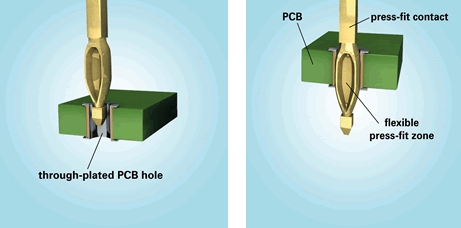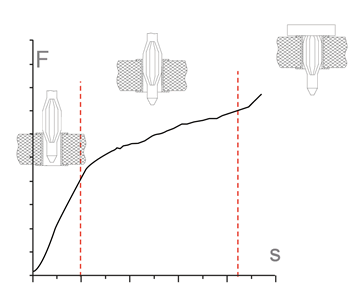Press-Fit Technology in Automotive Applications: Secure Electrical and Mechanical Connections in One Process Step
Safety-related features in automobiles are well-suited for press-fit systems
By Sandra Gast, Product Manager at ept GmbH
Press-fit technology is an especially reliable partner for automotive applications, where temperature fluctuations, shock, vibrations, moisture, dust, and dirt play a major role. It can be used to create a simultaneous electrical and mechanical connection in just one process step. What’s more, press-fit contacts offer significantly greater power transfer than solder contacts thanks to their lower contact resistance of under 1mW. Press-fit connections can be used at temperatures ranging from -40°C to +150°C and can readily withstand vibrations of up to 20G. As a result, they have been used successfully for years, primarily in safety-related applications such as ABS systems.
The Press-Fit Connection
The purpose of a press-fit connection is to create a permanent mechanical and electrically conductive connection between the PCB and connectors. In order to accomplish this, the diagonal of the press-fit system has to be larger than the diameter of the metalized hole in the PCB. The contact is pressed into the PCB hole by applying just the right force. This results in cold welding between the press-fit pin and the contacted PCB hole. Cold welding joins the outer metal atoms of the PCB hole and press-fit pin, creating a stable atomic lattice. This type of connection comes very close to thermal welding. The final result is a gas-tight and mechanically resilient connection that conducts electricity with great reliability.
Press-fitting is intended to cause cold welding, but with minimal deformation of the hole wall. With the flexible press-fit system, this challenge is resolved by means of the elastic zone. The elastic zone absorbs the force and deforms itself so that the wall of the PCB hole is not damaged.

The Ratio of the Press-Fitting Force to the Holding Force Is Integral to Quality
The highest possible holding force has to be achieved with the minimum possible press-fitting force. The holding force is indicative of the cold welding quality. The higher the holding force, the stronger the mechanical connection. This is an important characteristic value, especially as it relates to the system’s ability to withstand shocks and vibrations.
A press-fit system can meet very different requirements depending on the contact material, material thickness, hole diameter, and coating of the contact and PCB hole. For example, high-speed signals of more than 40Gb/s, or currents up to 45A, can be transmitted. While the smallest possible hole diameter is required for signal transmission, a large hole diameter is helpful for current transmission.
It’s All About Using the Right Tools
One important factor in the quality of the press-fit system is the process itself. Ideally, the press-fit tool should be individually adapted to the connector. The top tool transmits the force of the press to the individual pins. The bottom tool, by contrast, is designed to prevent the applied force from damaging the other components on the PCB or the PCB itself. Both tools therefore need to be perfectly compatible with each other.

The force/stroke monitoring indicates the press-fit forces expended throughout the entire press-fit process.
Finally, a press with force/stroke monitoring should be used not only to ensure the press-fit connection is reliable, but also to prove it. Monitoring makes it possible to observe and document the press-fit process seamlessly.
Recently posted:
[related_posts limit=”10″]






